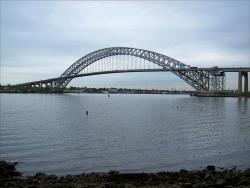
The longest steel-arch bridge in the world for 46 years, the Bayonne Bridge continues to be celebrated today as a major aesthetic and technical achievement. The 1,675-foot bridge replaced a ferry service which until then was the only means of crossing from the Bayonne peninsula to Staten Island. While providing this essential link in the transportation network of greater New York City, the bridge's mid-span clearance of 150 feet also allows for unobstructed navigation on Newark Bay, the main shipping channel to the inland ports of Newark and Elizabeth, New Jersey.
The engineering achievements of the Bayonne Bridge include the first use of manganese steel for main structural elements, several advances in structural analysis, and an innovative system of falsework used in its construction. Its design is one of many in the New York City area representing the work of Othmar H. Ammann, whose majestic George Washington Bridge was opened less than a month earlier.
Facts
- The Bayonne Bridge has been widely recognized as an engineering work of great artistic accomplishment. The American Institute for Steel Construction awarded it a prize in 1931 for most beautiful steel-arch bridge, and The New York Times, in a later tribute, said "there is a symmetry and fineness of detail about the Bayonne Bridge that is impressive and almost haunting.
- The bridge's design is based in part on New York City's 1917 Hell Gate Bridge, on which Ommann worked as chief assistant to noted engineer Gustav Lindenthal. In its time, the Hell Gate Bridge, at 977 feet, was the longest steel-arch bridge in the world. The Bayonne Bridge surpassed it by nearly 70 percent, and remained the world's longest steel-arch bridge until the 1970 opening of the 1,700-foot New River Gorge Bridge at Fayetteville, West Virginia.
- The design of the Sydney Harbour Bridge, which opened in 1932 with a span shorter by only five feet, closely resembles that of the Bayonne Bridge. After the opening of the Bayonne Bridge, the golden shears used in its ribbon-cutting ceremony were sent to Australia for use at the opening of the Sydney Harbour Bridge, then dismantled so each country could keep one blade as an historic memento.
- Calculations of secondary stresses helped make the construction of a structure as large as the Bayonne Bridge possible. These had tended to be ignored in the design of earlier bridges and were later checked by extensometers on the actual structure. Design calculations also included compression tests on the largest columns of manganese steel ever made.
- Falsework secured on solid rock below the water was used in the Bayonne Bridge's construction to avoid the need for heavy anchorages and abutment towers in the bridge's design. The falsework towers were made of material that was later used in the bridge.



- Engineering News Record, 19